Join More Than 50,000+ Subscribers and get latest camera news and rumors
NEW CAMERA VIDEOS ON YOUTUBE
|
By admin, on July 16th, 2022

New Tamrom 50-400mm Zoom lens with variable aperture F / 4.5-6.3 Di III VC VXD coming in the Sony block. The announcement is expected very soon. We will post an update on the official announcement stay tuned.
- TAMRON 50-400mm F / 4.5-6.3 Di III VC VXD
/ Sony E mount
/ Full size compatible
/ model A067
We already have the Sigma 100-400mm F5-6.3 DGDN OS Contemporary E-Mount @ $799 at amazon.com. But, with Tamron now we have a bit wider reach.
Follow us on our social pages FACEBOOK | TWITTER | INSTAGRAM, If you have time –>see more Sony Alpha Rumor
source – Digicam
By admin, on June 21st, 2022
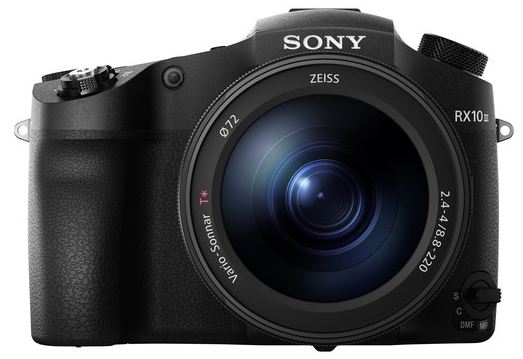
According to the latest rumors surfaced over the web, the Sony RX10 V Camera is expected to arrive in Q4 of 2022. According to the sources of the rumor mill, the camera will give a significant technological upgrade compared to its Hardware (Updated AI-AF, 3D tracking, and faster burst speed). The camera will also arrive with a larger Sony NP-FZ100 battery Although the Rumor mill is utterly silent on the type of sensor to be used inside the camera. The lens is expected to remain the same as we have seen in the Sony RX10 IV Camera.
Check the stock status ZV-E10 here – B&H Store | Amazon.com
Stay tuned for more updates
Follow us on our social pages FACEBOOK | TWITTER | INSTAGRAM, If you have time –>see more Sony Alpha Rumor
Source – SAR
By admin, on June 15th, 2022
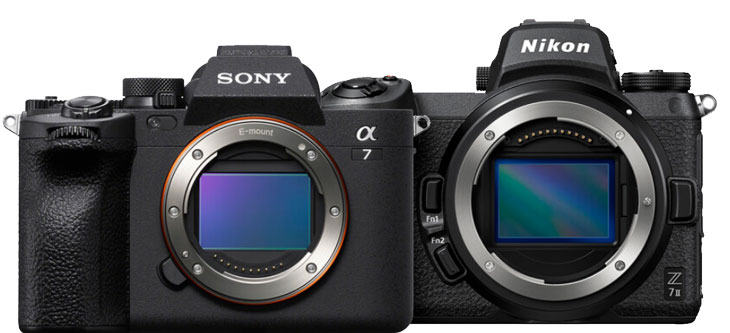
Let’s compare the Sony A7 IV vs Nikon Z7 Mark II, We are covering the Major difference between the two. And based on the Major differences, you should decide which camera should you buy.
You have to select your next camera based on
- your requirements and
- budget.
Either if you are a photographer, cinematographer, or content creator. You should buy your next camera based on your actual requirements and budget. There are a lot of people who buy cameras based on specs that they actually don’t use 90% of the time. So, just don’t get into those websites and videos, that only show the differences.
If you read the entire article, I will clear all your confusion and you can easily decide after that which Camera you should buy. In the first part, we will discuss the best camera for photographers between the Sony A7 IV and Nikon Z7 Mark II. And in the 2nd part of this article, we will discuss the best camera for cinematographers and content creators.

1. Best Camera for Photographers
Design Difference
Simple advice before we jump to any further discussion Nikon Professional DSLRs users should buy Nikon Z7 Mark II. If you are a Nikon user, you have already used Nikon professional DSLRs then it’s better to Buy the Nikon Camera again. The overall design, handgrip, and button placement all match with Nikon Professional Series DSLRs. Nikon professional DSLR shooters feel very comfortable with the body design of the camera. The top LCD display screen is the first major noticeable difference you will notice between the two. Nikon Z7 Mark II features a TOP LCD Display unit that A7 IV doesn’t have. Sony is in the 4th generation of its A7 Series Mirrorless cameras. The Sony A7 IV does miss out on the Top LCD Display Unit but features High Res.
Design-wise both are perfect for professionals and very well built. With Sony A7 IV Camera you get longer battery life and Vari-angle Display. For content creators too, the Sony A7 IV with the vari-angle display is the only choice
| Lens Mount |
Sony E |
Nikon Z |
| Sensor Resolution |
Actual: 34.1 Megapixel
Effective: 33 Megapixel |
Actual: 46.89 Megapixel
Effective: 45.7 Megapixel (8256 x 5504) |
| Sensor Type |
35.9 x 23.9 mm (Full-Frame) CMOS |
35.9 x 23.9 mm (Full-Frame) CMOS |
| Image Stabilization |
Sensor-Shift, 5-Axis |
Sensor-Shift, 5-Axis |
| Built-In ND Filter |
None |
None |
| Capture Type |
Stills & Video |
Stills & Video |

Core Specs comparison
Let’s discuss the major difference we have in the core specs of both cameras. The most important thing for a Photographer in a Camera is the image quality. In general, a camera that is capable to revolve MAX amount of details in a given scene is considered to be a very usable camera. AT base ISO range is very clearly visible and Nikon is able to grab more details compared to the Sony A7 IV camera.
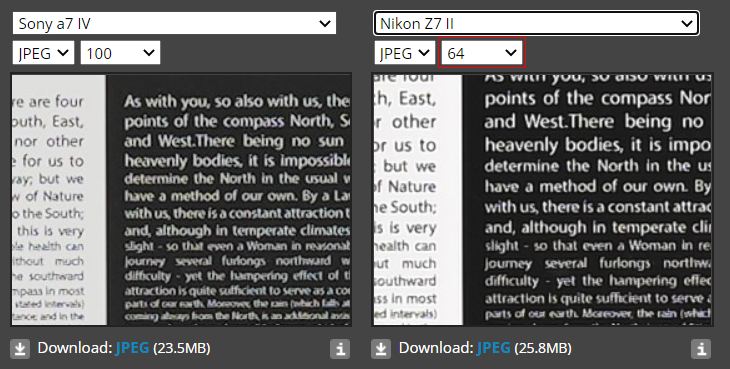
the credit of all the comparison images you see here www.dpreview.com/reviews/image-comparison?
It actually depends, When your priority is only the image quality, then we have different recommendations. If your priority is Image Quality as well as a Fast AF system, or You are a Hybrid Shooter and wish to have a perfect camera for Photo and Video then we have an entirely different set of recommendations.
We will only discuss the major differences between the two, not all the differences will be discussed in this video, to confuse you.
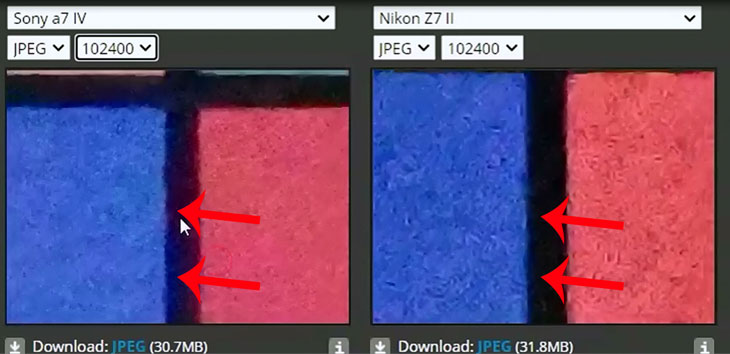
As you can see from the high ISO test files, the Nikon Z7 Mark II camera is preserving more color details compared to the Sony A7 IV camera.
2. Nikon Z7 Mark II vs Sony A7 IV High ISO Test
Nikon Z7 Mark II is not only able to capture more details compared to the Sony A7 IV but the NOISE of Z7 Mark II is also VERY WELL MAINTAINED at a Higher ISO Range During the test, it was very clearly visible that Nikon Z7 Mark II low-light performance is almost as good as that of the Sony A7 IV Camera. Closely notice the color block corners of the Sony A7 IV on the left side. Nikon Z7 II is able to preserve details better even at ISO 102400. Specifically the Jpeg Engine inside the Z7 Mark II camera doing a great job.
Best Camera for Photographers – If you care about details in your image – The Nikon Z7 Mark II
I am really very impressed with the image quality of the Nikon Z7 Mark II when compared to the Sony A7 IV, during the entire test. What I really care about the camera is image quality, when I have to pick a camera for photography purposes only.
| Shutter Type |
Mechanical Focal Plane Shutter, Electronic Shutter |
Mechanical Focal Plane Shutter, Electronic Shutter |
| Shutter Speed |
1/8000 to 30 Seconds |
Electronic Front Curtain Shutter
1/8000 to 900 Seconds |
| Bulb/Time Mode |
Bulb Mode |
Bulb Mode, Time Mode |
| ISO Sensitivity |
Photo
100 to 51,200 (Extended: 50 to 204,800)
Video
100 to 51,200 (Extended: 100 to 102,400) |
Photo/Video
64 to 25,600 in Auto Mode (Extended: 32 to 102,400) |
| Metering Method |
Center-Weighted Average, Highlight Weighted, Multiple, Spot |
Center-Weighted Average, Highlight Weighted, Matrix, Spot |
| Exposure Modes |
Aperture Priority, Manual, Program, Shutter Priority |
Aperture Priority, Auto, Manual, Program, Shutter Priority |
| Exposure Compensation |
-5 to +5 EV (1/3 EV Steps) |
-5 to +5 EV (1/3, 1/2 EV Steps) |
| Metering Range |
-3 to 20 EV |
-3 to 17 EV |
| White Balance |
Presets: Auto, Cloudy, Color Temperature, Color Temperature Filter, Custom, Daylight, Flash, Fluorescent (Cool White), Fluorescent (Day White), Fluorescent (Daylight), Fluorescent (Warm White), Incandescent, Shade, Underwater |
Presets: Auto, Cloudy, Color Temperature, Direct Sunlight, Flash, Fluorescent, Incandescent, Preset Manual, Shade |
| Continuous Shooting |
Up to 10 fps at 33 MP for up to 828 Frames (Raw) / Unlimited Frames (JPEG) |
Up to 10 fps at 45.7 MP for up to 50 Frames |
| Interval Recording |
Yes |
Yes |
| Self-Timer |
2/5/10-Second Delay |
2/5/10/20-Second Delay |
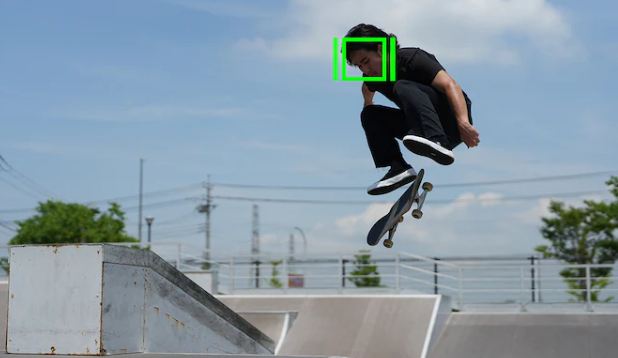
| Focus Type |
Auto and Manual Focus |
Auto and Manual Focus |
| Focus Mode |
Continuous-Servo AF, Direct Manual Focus, Manual Focus, Single-Servo AF |
Continuous-Servo AF, Full-Time Servo, Manual Focus, Single-Servo AF |
| Autofocus Points |
Phase Detection: 759
Contrast Detection: 425 |
Phase Detection: 493 |
| Autofocus Sensitivity |
-4 to +20 EV |
|
But, what’s the actual use of Sony’s Class-leading AutoFocus when the burst speed of the camera remains limited to 10fps with a lower-resolution sensor Nikon Z7 Mark II camera also features the same 10FPS shooting speed but with 45MP files.
Nikon Z7 Mark II Buffer depth – Buffer Depth RAW 77 files @ 45m and 200 JPEG. Sony A7 IV has a larger buffer depth of 800 RAW + JPEG Images
3. Why limited to 10 FPS in Sony A7IV?
Sony A7 IV features a class-leading AF system, despite a lower Megapixel than Nikon Z7 Mark II and Bionz XR image processing engine, the AF speed is locked at 10 FPS. So, in this scenario how we can openly recommend the Sony A7 IV to sports shooters or wildlife photographers.
Since Nikon Z7 mark II AF is now much improved, we are getting more details and very well-controlled noise at a high ISO range. it’s better to use Nikon Z7 Mark II with HQ lenses.
4. Reasons why you should buy the Sony A74 Camera as a photographer
- S-cinetone Sony Picture Profile resembles Canon color science
Canon users face Color science issues when they shift the brand. Instead of Nikon Z7 Mark II, Sony A7 IV with S-Cinetone PP is more recommended. Updated Menu Design – Limited operability of Sony Cameras isn’t an issue in Sony A7 IV camera with updated user interface and Menu designs. Latest Tamron 28-75mm F2.8 Lens resolves the Sony’s A7 IV 33 MP Sensor resolution perfectly. So, the overall cost of a camera and lens is lower compared to the Nikon Z7 II.
- SonyA7 IV is more budget-friendly compared to Nikon. 45 MP Sensor resolution of Nikon Z7 Mark II camera, isn’t easily digestible by Nikor 28-75mm F2.8 (the RXD version) You need to invest in High-Quality Lenses, no other option left in Nikon. Or they should open the mount ASAP.
5. Finally conclusion for photographers
If you are limited under a certain budget then for sure the Sony A7IV with its affordable Lens ECO system is highly useful to you. If budget isn’t an issue then go with Nikon Z7 Mark ii.
As you can see in the above comparison the Nikon Z7 Mark II camera captures more details than Sony and maintain low noise at a higher ISO. For Photographers, those who love details Nikon Z7 Mark II is highly recommended.
Nikon AF system is now improving with every announcement and Sony must understand this. The only reason I am recommending Sony A7 IV against Nikon Z7 Mark II to photographers is the ECO system and the S-cinetone picture profile.
6. Best Lenses for Z7 Mark II Camera
For Photographers – Buy Better Lenses for Z7 Mark II Camera
- Tamron 1st gen of 28-75mm F2.8 Re-branded lens isn’t recommended for Nikon Z7 Mk2
- If Tamron 28-75mm F2.8 G2 lens arrives under Nikon hood then only buy it for Z7 Mk 2
- In short – Invest in better lenses to get Max out from your Nikon Z7 Mark II camera
- If possible get the Trio – 14-24mm F2.8, 24-70mm F2.8, and 70-200mm F2.8 in Nikon.
- The overall cost of the Nikon Z7 mark II is higher than that of the Sony A7 IV with its affordable lens ECO system
Internal Video Capture
| Recording Modes |
H.265/XAVC HS 4:2:2 10-Bit
UHD 4K (3840 x 2160) at 23.98p/50p/59.94p [50 to 200 Mb/s]
H.265/XAVC HS 4:2:0 10-Bit
UHD 4K (3840 x 2160) at 23.98p/50p/59.94p [30 to 150 Mb/s]
H.264/XAVC S-I 4:2:2 10-Bit
UHD 4K (3840 x 2160) at 23.98p/25p/29.97p/50p/59.94p [240 to 600 Mb/s]
Full HD (1920 x 1080) at 23.98p/25p/29.97p/50p/59.94p [89 to 222 Mb/s]
XAVC S 4:2:2 10-Bit
UHD 4K (3840 x 2160) at 23.98p/25p/29.97p/50p/59.94p [100 to 200 Mb/s]
Full HD (1920 x 1080) at 23.98p/25p/29.97p/50p/59.94p [50 Mb/s]
XAVC S 4:2:0 8-Bit
UHD 4K (3840 x 2160) at 23.98p/25p/29.97p/50p/59.94p [60 to 150 Mb/s]
Full HD (1920 x 1080) at 23.98p/25p/29.97p/50p/59.94p/100p/119.88p [16 to 100 Mb/s] |
H.264/MOV/MP4 4:2:0 8-Bit
UHD 4K (3840 x 2160) at 23.98p/25p/29.97p/59.94p
Full HD (1920 x 1080) at 23.98p/25p/29.97p/50p/59.94p/100p/119.88p |
| Recording Limit |
Unlimited |
Up to 29 Minutes, 59 Seconds |
| Video System |
NTSC/PAL |
NTSC/PAL |
| Built-In Microphone Type |
Stereo |
Stereo |
| Audio Recording |
2-Channel 16-Bit 48 kHz LPCM Audio
2-Channel 24-Bit 48 kHz LPCM Audio
4-Channel 24-Bit 48 kHz LPCM Audio
2-Channel AAC LC Audio |
AAC Audio
2-Channel LPCM Audio |
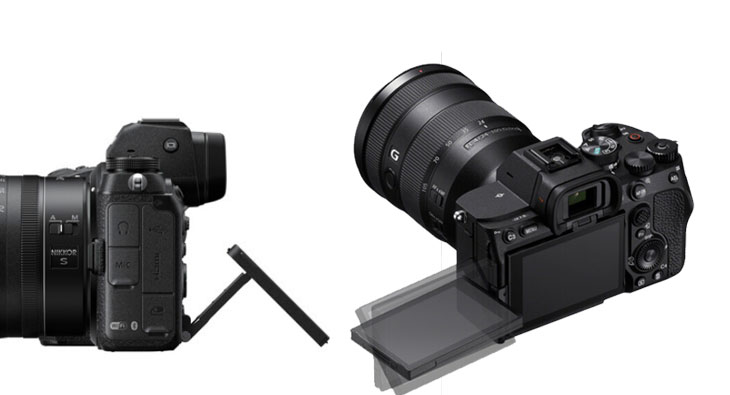
| External Recording Modes |
4:2:2 10-Bit via HDMI
UHD 4K (3840 x 2160) at 23.98p/25p/29.97p/50p/59.94p
Full HD (1920 x 1080) at 23.98p/50p/59.94p
Full HD (1920 x 1080) at 50i/59.94i
4:2:0 8-Bit via HDMI
UHD 4K (3840 x 2160) at 23.98p/25p/29.97p/50p/59.94p
Full HD (1920 x 1080) at 23.98p/50p/59.94p
Full HD (1920 x 1080) at 50i/59.94i |
4:2:2 10-Bit via HDMI
UHD 4K (3840 x 2160)Full HD (1920 x 1080) |
| IP Streaming |
None |
None |
7. Video Comparison – Sony A7 IV vs Nikon Z7 Mark II
Higher bit rates mean more quality – Sony A7 IV is more capable as a Video camera with higher bit rates – Sony 600mbps vs Nikon 144mbps
Pixel Binning OR Over-sampling in Nikon Z7 Mark II ?
Due to its higher pixel count, the Z7 II cannot read out its whole sensor quickly to produce high-quality oversampled files, we are talking about line-by-line reading as Sony does. Even while recording the 4K 24, 30 fps video the Nikon Z7 Mark II using somehow a mixture of Pixel Binning and Oversampled files.
Sony A7 IV does 7K full sensor readout
Sony A7 IV does a full sensor 33MP sensor readout. As well as in The Video. 3D AF tracking is also better than the Nikon Z7 Mark II. Sony A7 IV does 4K 30p 10-bit 4:2:2 recording, 4k 60p utilizes Super 35 crop/ APS-C area of the sensor (via 4.6k readout).
Overheating issue of Sony A7 IV
For content creators, the Sony Camera is the only option with a Vari-angle display screen. Sony A7 IV is a perfect Video camera, but it gets Overheat in Indian Summers. When the temp is around 35 to 40 degrees. IF anyone from Sony watching this video, kindly listen to the voice of your consumer-based of Asian Region and Kindly release a FIX for Overheating issue.
8. Best Video Camera
Undoublty the Sony A7 IV camera is a better option than the Nikon Z7 mark II. But, before buying A7 IV you should know the limitations too.
At Sony, We have options like Sony A7C and Sony A7S III for capturing uninterrupted video. If you want to buy a Video Camera in Nikon then you can also go with the Nikon Z6 Mark II. The Video quality of the Z6 Mark II is, even more, better than that of the Nikon Z7 Mark II. At Sony, We have cameras like the Sony A7S III and the Support of Third Party Lens makers is phenomenal
Buy Nikon Z7 Mark II Camera from B&H | Amazon.com
Best Camera for Video aka Alternatives – Sony A7C | Sony A7S III
Get Sony A7 IV Camera from B&H Store and Amazon.com
Best Lenses for Sony A7 IV
Sony A7 IV vs Canon R6 – Best Camera for Sports Photography?
Sony A7 IV vs Sony A7R III
Sony A7 IV vs Canon R6
By admin, on June 3rd, 2022
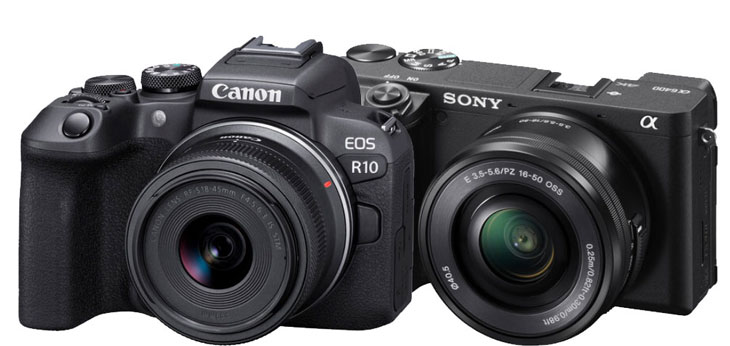
let’s compare the Sony A6400 camera with Canon R10. Camera. Let’s try to find out the major difference between the two cameras. Both of the cameras features conventional; CMOS Sensor, so you will get approx the same image quality from both the camera
Before we jump to the core specification let’s discuss the design part of both the camera.
1. Few Canon R10 Design features that impressed me a lot, which include
1.1 DSLR style hand-grip of the Canon R10 Camera
1.2 Joystick controller on the rear part of the camera
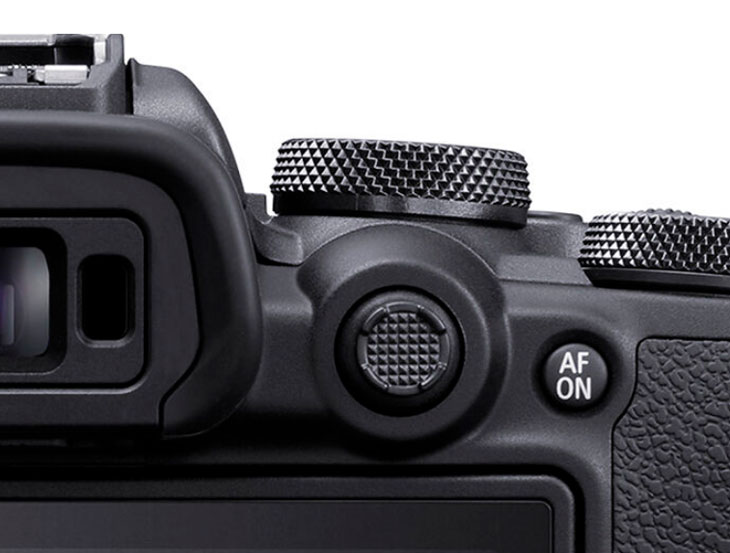
1.3 Placement of Viewfinder on Sony A6400 is on the extreme left, and in Canon R10 it is center.
1.4 Vari-angle display screen required for vlogging, with a Sony A6400 180 degree screen you have to face a few issues as your display will get blocked when you will use any type of microphone over the camera.
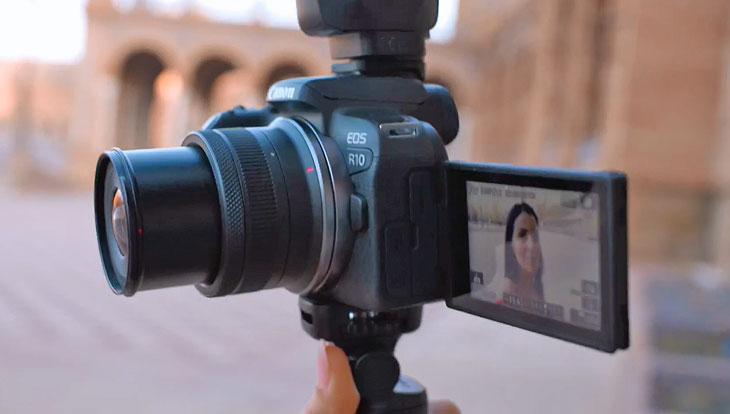
We also have a built-in flash in Canon R10, although I never recommend anyone to use those, At least buy some godox flashes if you want to use flash in photography.
For the first time a multi-function Hotshoe in Canon R10, although the Sony A6400 camera does have that. But, for the first time, Canon has to introduce and we have mentioned that.
2. Can Sony A6400 flip the Game?
2.1. The weather-sealed body
Sony A6400 camera features a weather-sealed body design, if your camera is weatherproof then for sure it will be more durable compared to the camera which is not so. Although to make it a complete weather-sealed package you have to invest in super expensive lenses which is not so possible if you planning to make an entire thing within a budget.
3. Missing the BSI and Stack Keywords in Sensor description?
|
Canon R10 |
Sony A6400 |
| Lens Mount |
Canon RF |
Sony E |
| Sensor Resolution |
Actual: 25.5 Megapixel
Effective: 24.2 Megapixel |
Actual: 25 Megapixel
Effective: 24.2 Megapixel (6000 x 4000) |
| Sensor Type |
22.3 x 14.9 mm (APS-C) CMOS |
23.5 x 15.6 mm (APS-C) CMOS |
| Crop Factor |
1.6x |
1.5x |
| Image Stabilization |
Digital (Video Only) |
Digital (Video Only) |
| Built-In ND Filter |
None |
None |
| Capture Type |
Stills & Video |
Stills & Video |
4. Redesigned Sensor in Canon R10
Canon R10 sensor is not the same sensor you have seen in the previous models, Canon has updated the microlenses of the sensor for more sharpness. So, Canon R10 with new RF lenses will deliver more sharpness compared to Canon’s previous generation of 24MP DPAF Sensors.
| Focus Type |
Auto and Manual Focus |
Auto and Manual Focus |
| Focus Mode |
Continuous-Servo AF, Manual Focus, Single-Servo AF |
Automatic, Continuous-Servo AF, Direct Manual Focus, Manual Focus, Single-Servo AF |
| Autofocus Points |
Photo, Video
Phase Detection: 651 |
Phase Detection: 425
Contrast Detection: 425 |
| Autofocus Sensitivity |
-4 to +20 EV |
-2 to +20 EV |
Canon added DPAF generation 2 inside the camera. With the addition of the Canon DPAF 2, the camera AI AF (artificially intelligence Autofocus) is now upscaled to the next level. Canon says they have added the same AF algo as they have used inside the Canon’s R3 camera.
5. AutoFocus Comparison
Canon R10 – With the introduction of the new DPAF system, We are now getting 651 AF zones in the Canon R10 Sensor, Earlier in the previous generation of Canon’s camera the AF Zones were limited to 143. The Canon R10 Sensor features more than 2.9K DPAF points which are grouped further into AF zones. The screen Coverage of the Canon R10 AF sensor is approx 100%, perfect for Wildlife shooters and sports photographers.
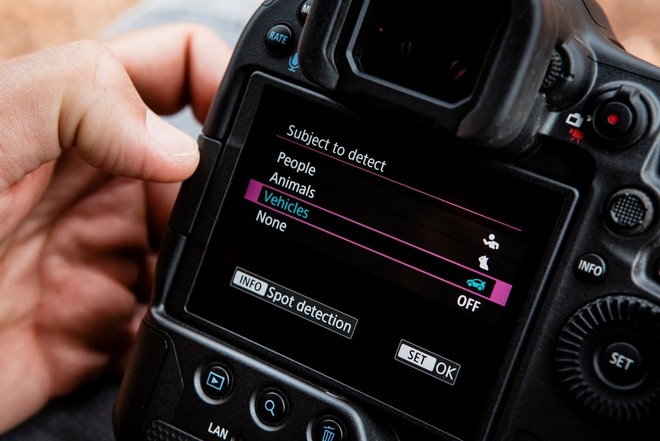
6. AF Modes in Canon R10
We have dedicated AF modes in the Canon R10 camera just like a Canon Professional DSLRs. The AF modes include People, Animals, Vehicles, and None. The Camera AI detects and keeps tracking the moving subject until the endpoint of the sensor frame.
Sony A6400 features 425 +425 Phase and contrast-detect AF points and covers approximately 84% of the sensor area. None of the dedicated AI AF modes are available inside the Sony A6400 camera and it needs an update.
If we compared all the info available to us, then we have a clear verdict that the AutoFocus System of the Canon R10 is much better and more advanced than the Sony A6400. But, it doesn’t mean the A6400 is inferior or unusable, it was a class-leading camera in in-terms AF performance before the announcement of the Canon R10.
| Shutter Type |
Electronic Shutter, Mechanical Focal Plane Shutter |
Mechanical Focal Plane Shutter, Electronic Shutter |
| Shutter Speed |
Mechanical Shutter
1/4000 to 30 Seconds
Electronic Shutter
1/4000 to 30 Seconds |
Mechanical Shutter
1/4000 to 30 Seconds
1/4000 to 1/4 Second in Movie Mode |
| Bulb/Time Mode |
Bulb Mode |
Bulb Mode |
| ISO Sensitivity |
Photo
100 to 32,000 in Manual, Auto Mode (Extended: 100 to 51,200) |
Photo
100 to 32,000 in Auto Mode (Extended: 50 to 51,200)
Video
100 to 3200 |
| Metering Method |
Center-Weighted Average, Evaluative, Partial, Spot |
Center-Weighted Average, Multi-Zone, Spot |
| Exposure Modes |
Aperture Priority, Manual, Program, Shutter Priority |
Aperture Priority, Auto, Manual, Program, Shutter Priority |
| Exposure Compensation |
-3 to +3 EV (1/3, 1/2 EV Steps) |
-5 to +5 EV (1/3, 1/2 EV Steps) |
| Metering Range |
-2 to 20 EV |
-2 to 20 EV |
| White Balance |
Presets: Auto, Cloudy, Color Temperature, Custom, Daylight, Flash, Fluorescent (White), Shade, Tungsten |
Presets: Auto, Cloudy, Color Temperature Filter, Custom, Daylight, Flash, Fluorescent (Cool White), Fluorescent (Day White), Fluorescent (Daylight), Fluorescent (Warm White), Incandescent, Shade, Underwater |
| Continuous Shooting |
Electronic Shutter
Up to 23 fps
Mechanical Shutter
Up to 15 fps |
Up to 11 fps |
| Interval Recording |
Yes |
Yes |
| Self-Timer |
2/10-Second Delay |
2/5/10-Second Delay |
7. Camera with Fastest Burst Speed?
Sony A6400 was the fastest camera in its class, before the arrival Canon R10. Sony A6400 camera remains limited to 11fps whereas the Canon R10 camera is able to shoot up to 23 FPS with an Electronic shutter up to 15 fps with a mechanical shutter.
8. Buffer Comparison
| Canon R10 Buffer |
Sony A6400 Buffer |
Electronic Shutter
Up to 23 fps at 24.2 MP for up to 70 Frames (JPEG) / 21 Frames (Raw)
Mechanical Shutter
Up to 15 fps at 24.2 MP for up to 460 Frames (JPEG) / 29 Frames (Raw) |
Up to 11 fps at 24.2 MP for up to 116 Frames (JPEG) / 46 Frames (Raw) |
9. Which one is better? 8 Bit vs 10 Bit?
According to the standard definition we have while recording 10-bit Videos, you can utilize 1,024 levels per channel. As a result, you can record more than 1 billion colors on your footage and while recording the 8-bit videos can display over 16.7 million colors.
10. Oversampled 10 Bit Videos in Canon Camera?
We would like to inform you before we begin, The Canon R10 camera is Canon’s first Canon under $1000 range that offers Oversampling of 6k videos down to 4K, and not only that you will also get 4k 24, 30fps video in 10Bit MP4 format under HDRPQ mode with MAX bitrate of 170Mbps.
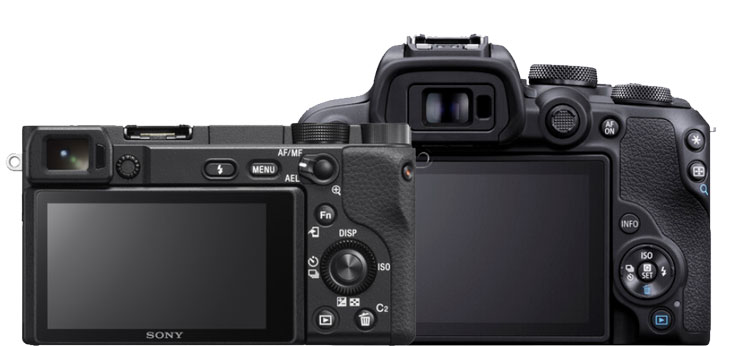
11. Best Budget Camera to Record 10Bit Videos?
With the Canon R10 Camera you are able to record 10-bit videos in HDRPQ format without any recording limit. So, when you will select the HDRPQ mode, you will get an option to record ultra high-quality 10bit 4k videos up to 30fps. The camera also has an option to record 4k 60fps but with an excessive 1.56x crop, so literally, it is not that usable.
12. Is Canon R10 safe from Cripple Hammer?
No, The Canon R10 isn’t safe from Canon Cripple Hammer. Since we don’t have any access to the log files of the Canon R10 camera. We are getting high Quality 10 BIT HDR Videos in MP4 format, but we don’t have any access to the log content inside the camera.
13. Best Video Camera Sony A6400 or Canon R10?
It depends on you, what you what to choose, on one side we have the Canon R10 camera with an option to record 10BIT videos in HDRPQ mode, and on the other side we have the Sony A6400 camera, limited to 8Bit, but we do have access to Slog and Slog 2. So, what do you want to choose a Camera with 10Bit but limited in MP4 format or a camera with 8 Bit and an open set of log files?
14. For fast-food lovers, the Canon R10 10bit is the best
If you are a vlogger, or wedding cinematographer and don’t have that much time to fight with log profiles and color – grading, better to eat a High-Quality pre-cooked food from Canon R10.
| Recording Modes |
H.264/MP4 4:2:0 8-Bit
UHD 4K (3840 x 2160) at 23.98p/25p/29.97p/59.94p
Full HD (1920 x 1080) at 23.98p/25p/29.97p/50p/59.94p/100p/119.88p
H.265/MP4 4:2:2 10-Bit
UHD 4K (3840 x 2160) at 23.98p/25p/29.97p/50p/59.94p
Full HD (1920 x 1080) at 23.98p/25p/29.97p/50p/59.94p/100p/119.88p |
XAVC S 4:2:0 8-Bit
UHD 4K (3840 x 2160) at 24.00p/25p/29.97p [60 to 100 Mb/s]
Full HD (1920 x 1080) at 23.98p/25p/29.97p/50p/59.94p/100p/119.88p [16 to 100 Mb/s] |
| Gamma Curve |
HDR-PQ / Unlimited recording |
Unlimited for UHD 4K (3840 x 2160) at 29.97p |
| Video System |
NTSC/PAL |
NTSC/PAL |
| Built-In Microphone Type |
Stereo |
Stereo |
| Audio Recording |
MP4: 2-Channel AAC Audio |
XAVC S: 2-Channel LPCM Audio |
15. Sony has the best Lens ECO system right now
Sony has opened its lens mount details to third-party lens makers back in 2018. And that;’s why right now we have a bunch of high-quality Sony APS-C Range of lenses which includes Sigma 18-50mm F2.8, Sigma 16mm F1.4, Sigma 30mm F1.4, and Sigma 56mm F1.4 and not only that we also have lenses in Tamron like 17-70mm F2.8 OIS. So, even in the APS-C zone in sony, we do have a great range of lenses.
16. Canon open your Lens Mount Like Sony
Sony has a much better ECO system right now compared to Canon, now it’s time for Canon to open their lens mount and allow third-party lens makers to make their lenses freely without any trouble or any reverse engineering method.
Verdict:
If we compare the specification only on the still photography side then for sure for still shooters we highly recommend the Canon R10 camera, and even in the video if you like to have a 10Bit camera in the $1000 price range then for sure Canon R10 is the only choice we have. But as usual, we are not able to forget here the range of lenses available with Sony, and that will play a huge role while taking the final decision. Although, in Canon, we do have third-party lens makers like Viltro coming up with their lenses and also an option to use all DSLR lenses with an EF to EOS R adapter.
|
Canon R10 |
Sony A6400 |
| Media/Memory Card Slot |
Single Slot: SD/SDHC/SDXC (UHS-II) |
Single Slot: SD/SDHC/SDXC/Memory Stick Duo Hybrid (UHS-I) |
| Video I/O |
1 x Micro-HDMI Output |
1 x Micro-HDMI Output |
| Audio I/O |
1 x 1/8″ / 3.5 mm TRS Stereo Microphone Output |
1 x 1/8″ / 3.5 mm TRS Stereo Microphone Input |
| Other I/O |
1 x USB Type-C (USB 2.0) Input/Output |
1 x USB Type-C (USB 3.2 / 3.1 Gen 1) Input/Output (Shared with Power Input) |
| Wireless |
2.4 GHz Wi-Fi (802.11b/g)
Bluetooth |
Bluetooth WiFi |
|
|
|
| Size |
3.0″ |
3.0″ |
| Resolution |
1,040,000 Dot |
921,600 Dot |
| Display Type |
Free-Angle Tilting Touchscreen LCD |
Articulating Touchscreen LCD |
| Type |
Built-In Electronic (OLED) |
Built-In Electronic |
| Resolution |
2,360,000 Dot |
2,359,296 Dot |
| Eye Point |
22 mm |
23 mm |
| Coverage |
100% |
100% |
| Magnification |
Approx. 0.95x |
Approx. 1.07x |
| Diopter Adjustment |
-3 to +1 |
4 to +3 |
| Built-In Flash |
Yes |
No |
| Guide Number |
19.7′ / 6 m at ISO 100 |
Auto, Fill Flash, Off, Rear Sync, Slow Sync |
| Maximum Sync Speed |
1/250 Second |
1/160 Second |
| Flash Compensation |
-3 to +3 EV (1/3, 1/2 EV Steps) |
-3 to +3 EV (1/3 EV Steps) |
| Dedicated Flash System |
eTTL |
TTL |
| External Flash Connection |
Hot Shoe |
Intelligent Hot Shoe |
| Battery Type |
1 x LP-E17 Rechargeable Lithium-Ion |
1 x NP-FW50 Rechargeable Lithium-Ion, 7.2 VDC, 1080 mAh (Approx. 440 Shots) |
| Dimensions (W x H x D) |
4.8 x 3.5 x 3.3″ / 122.5 x 87.8 x 83.4 mm |
4.5 x 2.5 x 1.8″ / 115.2 x 64.2 x 44.8 mm |
| Weight |
13.5 oz / 382.2 g (Body Only)
15.1 oz / 429.2 g (Body with Battery and Memory) |
12.1 oz / 343 g (Body with Battery and Memory) |
Hope you like this specification comparison.
How you can encourage us – Put A comment of appreciation or buy your next camera and lens from amazon or B&H Store and it will earn us an affiliate commission.
Check the Latest Price of Canon R10 at B&H Store and Amazon.com | B&H Store
Also, see – Canon R10 vs Sony ZV-E10
See All Comparison & Content Related to Canon R10 Here
More inclined towards Sony A6400? Take a look at the best Lenses for Sony A6400
By admin, on May 28th, 2022
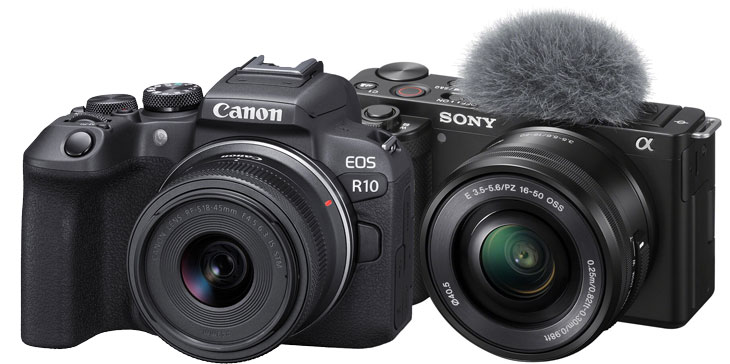
Canon R10 is a recently announced Hybrid camera. And Sony ZV–E10 is a dedicated V-logging interchangeable Lance camera. So which one of these is more suitable for photography and which one is more recommended for videography and cinematography?
Let’s discuss some basics: The Canon R10 and the Sony’s ZV E10 camera uses conventional CMOS sensors, none of these cameras are equipped with a BSI or a stacked CMOS sensor. At the same time, the resolution of both the cameras is exactly the same.
Updated Image Sensor in Canon R10
Canon has updated the microlens structure of their 24.2 mp APS-C CMOS sensor, so we may expect a little bit more sharpness from the canon R10 camera. All though we have to wait for studio test results to confirm this feature.
Now in photography not only image quality, but The autofocusing system is also a very important or integral part of the entire process
|
Canon R10 |
Sony ZV-E10 |
| Lens Mount |
Canon RF |
Sony E |
| Sensor Resolution |
Actual: 25.5 Megapixel
Effective: 24.2 Megapixel |
Actual: 25 Megapixel
Effective: 24.2 Megapixel (6000 x 4000) |
| Sensor Type |
22.3 x 14.9 mm (APS-C) CMOS |
23.5 x 15.6 mm (APS-C) CMOS |
| Crop Factor |
1.6x |
1.5x |
| Image Stabilization |
Digital (Video Only) |
Digital (Video Only) |
| Built-In ND Filter |
None |
None |
| Capture Type |
Stills & Video |
Stills & Video |
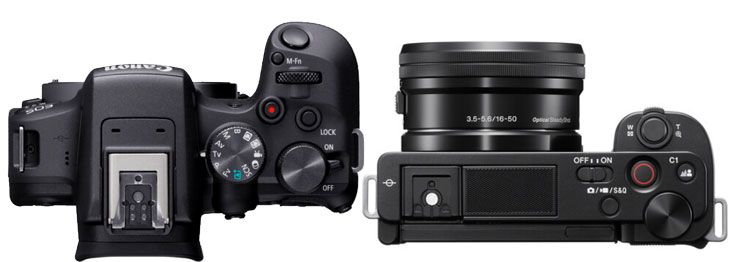
Autofocusing System
We know that both Canon and Sony make the world’s best autofocusing systems. But this time Canon has upscaled the dual pixel CMOS autofocusing system even in the mid-range camera. Now we are getting the 2nd generation of dual pixel CMOS autofocusing system in Canon R10. camera. And dedicated tracking modes to track animals, vehicles which include moving cars motorbikes, etc., as well as an artificially intelligent AF force to track any 3D moving subject.
| Focus Type |
Auto and Manual Focus |
Auto and Manual Focus |
| Focus Mode |
Continuous-Servo AF, Manual Focus, Single-Servo AF |
Automatic, Continuous-Servo AF, Direct Manual Focus, Manual Focus, Single-Servo AF |
| Autofocus Points |
Photo, Video
Phase Detection: 651 |
Phase Detection: 425
Contrast Detection: 425 |
| Autofocus Sensitivity |
-4 to +20 EV |
-3 to +20 EV |
Canon R10 features 651 Autofocusing zones in the sensor and is fabricated with 3975 AF points. Sony Hybrid AF points and limited to 451 as well as contrast-detect AF points. So, if we compare both then Canon R10 does leads in core specs of the AF system. Although we have to also consider the Sony ZV-E10 camera also features a dedicated vlogging mode which is more usable to vloggers.
Burst mode – Canon RF features an electronic and mechanical shutter, the Max shooting speed is 23 Frames per second, up to 70 Frames (JPEG) / 21 Frames (Raw). And with a mechanical shutter, you are able to capture 15fps per second at 24.2 MP for up to 460 Frames (JPEG) / 29 Frames (Raw). Sony ZV-E10’s continuous shooting speed is limited to Up to 11 fps at 24.2 MP for up to 116 Frames (JPEG) / 46 Frames (Raw).
|
Canon R10 |
Sony ZV-E10 |
| Shutter Type |
Electronic Shutter, Mechanical Focal Plane Shutter |
Mechanical Focal Plane Shutter, Electronic Shutter |
| Shutter Speed |
Mechanical Shutter
1/4000 to 30 Seconds
Electronic Shutter
1/4000 to 30 Seconds |
Mechanical Shutter
1/4000 to 30 Seconds
1/4000 to 1/4 Second in Movie Mode |
| Bulb/Time Mode |
Bulb Mode |
Bulb Mode |
| ISO Sensitivity |
Photo
100 to 32,000 in Manual, Auto Mode (Extended: 100 to 51,200) |
Photo
100 to 32,000 in Auto Mode (Extended: 50 to 51,200)
Video
100 to 3200 |
| Metering Method |
Center-Weighted Average, Evaluative, Partial, Spot |
Center-Weighted Average, Multi-Zone, Spot |
| Exposure Modes |
Aperture Priority, Manual, Program, Shutter Priority |
Aperture Priority, Auto, Manual, Program, Shutter Priority |
| Exposure Compensation |
-3 to +3 EV (1/3, 1/2 EV Steps) |
-5 to +5 EV (1/3, 1/2 EV Steps) |
| Metering Range |
-2 to 20 EV |
-2 to 20 EV |
| White Balance |
Presets: Auto, Cloudy, Color Temperature, Custom, Daylight, Flash, Fluorescent (White), Shade, Tungsten |
Presets: Auto, Cloudy, Color Temperature Filter, Custom, Daylight, Flash, Fluorescent (Cool White), Fluorescent (Day White), Fluorescent (Daylight), Fluorescent (Warm White), Incandescent, Shade, Underwater |
| Continuous Shooting |
Electronic Shutter
Up to 23 fps at 24.2 MP for up to 70 Frames (JPEG) / 21 Frames (Raw)
Mechanical Shutter
Up to 15 fps at 24.2 MP for up to 460 Frames (JPEG) / 29 Frames (Raw) |
Up to 11 fps at 24.2 MP for up to 116 Frames (JPEG) / 46 Frames (Raw) |
| Interval Recording |
Yes |
Yes |
| Self-Timer |
2/10-Second Delay |
2/5/10-Second Delay |
Video Capture
Canon R10 now captures oversampled 6k, and the camera also has the ability to capture 10BIT 4:2: videos in HDRPQ mode (output under MP4 wrapper), but at the same time, we have to admit the fact that no CLog is available in the camera… So now you can record high-quality 4k oversampled 10bit videos @ 24 and 30fps from the Canon R10 Camera. There is also an option to capture 4K 60p videos but at the same time, the video is excessively cropped so not so usable. Canon revoked the 30min time limit on the Canon R10 camera, for super slo-mo videos you also have an option to record Full HD Videos up to 120 FPS (With DPAF and no crop).
Sony ZV-E10 camera – Very suable camera at its price range, it does adore all bell and whistles that Camera perfect vlogging camera should have. But missing the 10-bit video recording mode like the Canon R10 camera. Sony ZV-E10 also does oversample and records videos up to 4k 60fps. We also have dedicated VLogging AF modes, like Product priority AF and beauty filters too.
|
Canon R10 |
Sony ZV-E10 |
| Recording Modes |
H.264/MP4 4:2:0 8-Bit
UHD 4K (3840 x 2160) at 23.98p/25p/29.97p/59.94p
Full HD (1920 x 1080) at 23.98p/25p/29.97p/50p/59.94p/100p/119.88p
H.265/MP4 4:2:2 10-Bit
UHD 4K (3840 x 2160) at 23.98p/25p/29.97p/50p/59.94p
Full HD (1920 x 1080) at 23.98p/25p/29.97p/50p/59.94p/100p/119.88p |
XAVC S 4:2:0 8-Bit
UHD 4K (3840 x 2160) at 24.00p/25p/29.97p [60 to 100 Mb/s]
Full HD (1920 x 1080) at 23.98p/25p/29.97p/50p/59.94p/100p/119.88p [16 to 100 Mb/s] |
| Gamma Curve |
HDR-PQ |
Unlimited for UHD 4K (3840 x 2160) at 29.97p |
| Video System |
NTSC/PAL |
NTSC/PAL |
| Built-In Microphone Type |
Stereo |
Stereo |
| Audio Recording |
MP4: 2-Channel AAC Audio |
XAVC S: 2-Channel LPCM Audio |
Added Advantage
Headphone port – Being more affordable than the Canon R10 Camera, the Sony ZV-E10 features a dedicated headphone port to monitor the audio which is absent in the Canon R10 Camera. Another added advantage is a built-in High-Quality microphone, the ZV-E10 features a high-Quality microphone that is able to cut the external noise and will allow you to enter a clear voice only.
| Media/Memory Card Slot |
Single Slot: SD/SDHC/SDXC (UHS-II) |
Single Slot: SD/SDHC/SDXC/Memory Stick Duo Hybrid (UHS-I) |
| Video I/O |
1 x Micro-HDMI Output |
1 x Micro-HDMI Output |
| Audio I/O |
1 x 1/8″ / 3.5 mm TRS Stereo Microphone Output |
1 x 1/8″ / 3.5 mm TRS Stereo Headphone Output
1 x 1/8″ / 3.5 mm TRS Stereo Microphone Input |
| Other I/O |
1 x USB Type-C (USB 2.0) Input/Output |
1 x USB Type-C (USB 3.2 / 3.1 Gen 1) Input/Output (Shared with Power Input) |
| Wireless |
2.4 GHz Wi-Fi (802.11b/g)
Bluetooth |
2.4 GHz Wi-Fi (802.11b/g)
Bluetooth |
| Global Positioning (GPS, GLONASS, etc.) |
Bluetooth, Wi-Fi |
Bluetooth, Wi-Fi |
|
None |
None |
Monitor
| Size |
3.0″ |
3.0″ |
| Resolution |
1,040,000 Dot |
921,600 Dot |
| Display Type |
Free-Angle Tilting Touchscreen LCD |
Articulating Touchscreen LCD |

Viewfinder for Photographers
The viewfinder is completely absent in the Sony ZV-E10 camera whereas in Canon R10 features an EVF of 2.36 Million dot EVF and even in that you have an OVF mode for those who have a habit of using OVF in DSLRs.
| Type |
Built-In Electronic (OLED) |
| Resolution |
2,360,000 Dot |
| Eye Point |
22 mm |
| Coverage |
100% |
| Magnification |
Approx. 0.95x |
| Diopter Adjustment |
-3 to +1 |
Flash – Canon R10 supports internal flash whereas the ZV-E10 doesn’t have internal flash.
| Built-In Flash |
Yes |
No |
| Guide Number |
19.7′ / 6 m at ISO 100 |
Auto, Fill Flash, Off, Rear Sync, Slow Sync |
| Maximum Sync Speed |
1/250 Second |
1/160 Second |
| Flash Compensation |
-3 to +3 EV (1/3, 1/2 EV Steps) |
-3 to +3 EV (1/3 EV Steps) |
| Dedicated Flash System |
eTTL |
TTL |
| External Flash Connection |
Smart Hot Shoe |
Intelligent Hot Shoe |
General
| Battery Type |
1 x LP-E17 Rechargeable Lithium-Ion (Approx. 350 Shots) |
1 x NP-FW50 Rechargeable Lithium-Ion, 7.2 VDC, 1080 mAh (Approx. 440 Shots) |
| Tripod Mounting Thread |
1 x 1/4″-20 Female (Bottom) |
1 x 1/4″-20 Female (Bottom) |
| Dimensions (W x H x D) |
4.8 x 3.5 x 3.3″ / 122.5 x 87.8 x 83.4 mm |
4.5 x 2.5 x 1.8″ / 115.2 x 64.2 x 44.8 mm |
| Weight |
13.5 oz / 382.2 g (Body Only)
15.1 oz / 429.2 g (Body with Battery and Memory) |
12.1 oz / 343 g (Body with Battery and Memory) |
Check the Latest Price & Stock status at – Canon R7 at B&H Store | Canon R7 at Amazon.com
Check the Latest Price & Stock status Sony ZV-E10 B&H Store | Sony ZV-E10 Amazon USA
Conclusion
For Still Shooters – If ur a photographer then yes Canon R10 features a perfect handgrip, an EVF. And also you get HDRPQ (HEIF) format for stills. And the ability to capture faster frames up to 23 fps and with a mechanical shutter up to 15 fps. And advance 2nd gen DPAF system with different modes and a larger AF group for perfect 3d subject tracking. I am not comparing image quality here since both of these cameras carry conventional CMOS sensors, so more or less both of them will produce similar output.
Recommendation – Camera Wise – Canon R10 Seems to be a perfect choice for photographers.
Best Video Camera The ability to record 10bit video makes Canon R10 a perfect camera for Videographers, beginner cinematographers, and Vloggers. Although the 10bit is limited to MP4 wrapper, yes you will get more details and latitude in your files compared to an 8bit file from ZV-E10. Although the Sony ZV-E10 does offer S-log profiles even those that are limited to 8-bit format. And yes an option to record in ALL-I Intra format whereas the Canon R10 recording formats in 4K are limited to IPB and IPB Light.
If Sony ZV-E10 was able to give us 10bit in any way, I would here definitely recommend the ZV-E10 camera for Video work. but since the camera is limited to 8bit only, So R10 is able to make a perfect space here with its HDRPQ 10-bit mode. Decide yourself, I would recommend you to get a 10bit camera since 8-bit videos can display over 16.7 million colors. When you switch to a 10-bit video, you can use more than 1 billion colors for your footage.
But if we consider the LENS ECOSYSTEM – We know that the Canon Lens mount is still closed to third-party lens makers, and at the same time, we have multiple options for Sony since they have publicly opened their E-Mount in 2018.
So, lenses like Sigma 18-50mm F2.8 | Tamron 17-70mm F2.8 | Primes like Sigma 56mm F1.4 | 30mm F1.4 and 16mm F1.4 always attract eyes over them. The list doesn’t end here we have more than dozen of popular APS-C lenses for the Sony E-Mount camera.
In Canon, if you already own Canon DSLR Lenses, then for sure you should only buy the Canon R10 Camera.
Final Verdict – If the available set of lenses and Price of Canon R10 fits to your budget and requirements for with Canon R10 Camera then, otherwise ZV-E10 is a decent option to have if available.
By admin, on May 16th, 2022
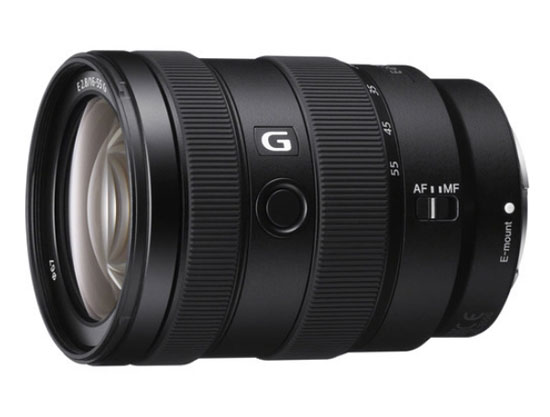
Sony is finally in the mood to announce new APS-C Lenses for their APS-C Mirrorless line-up. As we all know third-party lens makers have given us amazing options like Sigma 18-50mm F2.8, and Tamron 17-70mm F2.8 OIS, and of course, Sigma trio primes are very popular among Sony users.
Sony isn’t putting that much attention on APS-C Lenses for the past few years and we all know this year it’s not possible for Sony to announce new APS-C camera bodies, due to the semi-conductor crisis. So, we the lenses for APS-C consumers.
Follow us on our social pages FACEBOOK | TWITTER | INSTAGRAM, If you have time –>see more Sony Alpha Rumor
source youtube
By admin, on May 9th, 2022
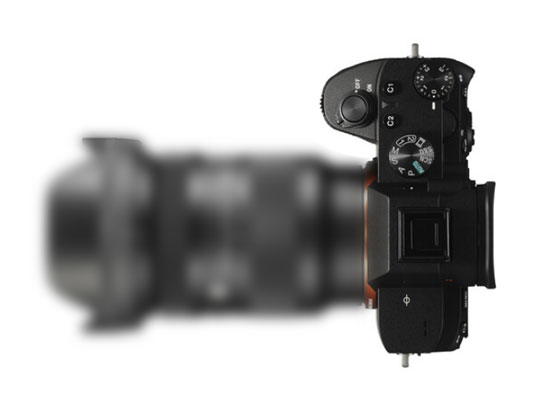
According to the recent patent surfaced, Sigma is working on a brand new lens with a focal length of 28 to 85mm f2.8, and not only this lens in the same patent document you will also find the 24 to 70 mm F2.8 as well as the 28 to 70 mm F2.8.
As we all know there is a huge market for 24 to 70 mm focal range with a 2.8 aperture and the biggest problem is native lenses of Sony’s are costly or either you have to buy an F4 aperture or variable aperture based native kit lens, and so these third-party lens makers aggressively working in this particular focal range to offer multiple solutions to consumers at an affordable price tag to gain maximum market share possible.
Popular Sony Lenses among photographers and cinematographers
A long time ago, Tokina had a zoom called AT-X28-80mm f2.8. At that time, everyone was surprised at the brightness and the low price. I think Sigma wants to create the same lens again.
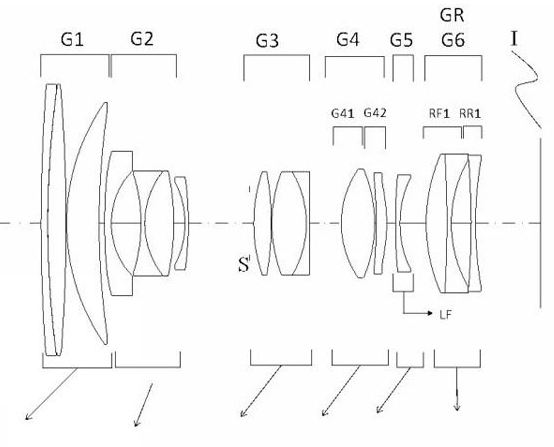
Patent Details
- Applicant: Sigma Co., Ltd.
Publication number: P2022067732
Application number: P 2020176481
Publication date: 2022-05-09 Title
of invention: Large-diameter zoom lens
More patent details here
- Example 1 (24-70mm F2.8)
Zoom ratio 2.75 Wide-
angle intermediate telephoto
focal length 24.72 39.76 67.98
F number 2.92 2.92 2.92
Full angle of view 2ω 85.24 56.96 34.33
Image height Y 21.63 21.63 21.63
Lens total length 135.00 145.60 171.09
Back focus 17.6206 17.6036 17.5749
- Example 3 (28-70mm F2.8)
Zoom ratio 2.35 Wide-
angle intermediate telephoto
focal length 28.81 40.01 67.69
F number 2.92 2.92 2.92
Full angle of view 2ω 75.92 56.06 33.85
Image height Y 21.63 21.63 21.63
Lens total length 120.04 126.08 142.66
Back focus 19.6292 19.5884 19.6020
- Example 4 (28-85mm F2.8)
Zoom ratio 2.90 Wide-
angle intermediate telephoto
focal length 28.79 49.98 83.51
F number 2.92 2.92 2.92
Full angle of view 2ω 75.61 45.42 27.77
Image height Y 21.63 21.63 21.63
Lens total length 135.02 146.97 164.94
Back focus 17.6146 17.5433 17.5817
Follow us on our social pages FACEBOOK | TWITTER | INSTAGRAM, If you have time –>see more Sony Alpha Rumor
source digicam
|
KEEP THIS BLOG ALIVE - Support New Camera Buy Canon Lenses, Buy Music CD or Digital Camera at amazon it helps this site, and you do not pay anything extra, it is just a way to help support this site.

|
























